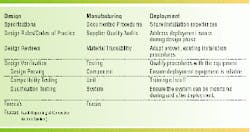Technology addresses intelligent completions' reliability issue
Editor's Note: With little industry-wide direction for applications development of intelligent completion (IC) systems, and technology to support those applications, many solutions are evolving. The following addresses the most critical issue delaying implementation of IC technologies - reliability.
The simplified model used in a dual choke completion application. The reliability performance figures apply for the downhole components of the Admarc system, from the tubing hanger wet mate connectors, down.
Technical papers continue to be written on the virtues of Smart Welltrademark or intelligent completions (IC) technologies. A number of oil and gas operating companies have already taken the step of deploying these systems, and not surprisingly with new technologies, there have been somewhat mixed results.
Since 1997, ABB has been developing a downhole intelligent well system called Admarc (advanced downhole monitoring and reservoir control). The company has recognized from project outset that the predicted economic gains offered by any intelligent-well systems are illusory, unless the equipment proves reliable in service. In subsea well applications, maintenance is an extremely expensive option, and yet it is the subsea well applications where the operators have the most to gain.
In determining the desired reliability of an intelligent well system, a multitude of variables must be con sidered, balancing those such as equipment capital costs and available technology against the consequences of system failures. These variables will obviously change from one reservoir and field application to another.
Failure probability
Realism must be applied in setting reliability expectations for intelligent well systems. The harsh installation and operating conditions make a zero failure expectation over a 10-15 year life span basically unachievable. For example, Shell has been noted of setting a reliability target of 90% survivability after five years for monitoring systems, and 90% survivability after 10 years for actuators.
Clearly, intelligent well systems have greater complexity. As a result, ABB decided that this was the time for a new approach to the reliability issue for downhole completion systems. There are many lessons that can be learned from other industrial applications of electro-mechanical devices and systems. They can be applied to the oil and gas industry in enhancing the reliability of downhole systems.
ABB's solution to the problem assumes that there will be some failures, and they combat this by developing a highly fault-tolerant system. The Admarc system has been designed around this basic premise - but it has also been underpinned by an exceptionally rigorous approach to component design material selection, testing and reliability analysis.
Reliability work
A group of scientists at the Research Centre in Billingstad, Norway, who have become expert in reliability, was charged with addressing the reliability issue of intelligent completions. Although strictly addressing the Admarc system, much of the ensuing methodologies and process improvements would apply equally well to all such systems, regardless of supplier.
The overall objective of this project has been to ensure satisfactory system reliability and operational performance on a long-term basis, for relevant well applications. To achieve this objective, systematic component criticality assessments and reliability performance simulations have been applied as decision support tools during the design process to eliminate possible bottlenecks and "reliability killers."
In all reliability analysis work, it is necessary to gain agreement and a clear understanding of the definition of failure to be used. It was decided that in the case of intelligent wells the definition to be used would be: "Lost ability to remotely operate the downhole flow control device." In the case of multiple choke applications the definition would expand to: "Lost ability to remotely operate one, or more, downhole flow control devices."
Reliability philosophy
Four failure source areas have been identified: design, manufacturing, deployment, and operations. Identifying these four areas led to development of a reliability philosophy:
- Make different system configurations available and provide reliability comparisons for cost-reliability evaluations.
- Develop a high integrity system. No single failure should cause a loss of the system.
- Selection of components and technology should be based on reliability considerations.
- Investment in research activities improves reliability.
Analysis work performed to date has provided quantitative estimates of system reliability. In particular, the impact of high temperature rated (220°C) electronics together with redundancy for critical components has been quantified.
Reliability analysis consists of the following steps:
- Establish input data: This has been an extensive task due to absence of absolute, relevant field data. Extensive effort has been allocated to obtain and calibrate input data from various sources such as laboratory tests, manufacturers and generic/field. Supplementary reliability techniques such as fault tree analysis, reliability block diagrams and expert judgement techniques have been applied to prepare and adjust the input data.
- Failure mode, effect and criticality analysis (Fmeca): The analysis has been performed to systematically assess possible failure modes and corresponding effects on the system. The "essence" of the Fmeca analysis has acted as input to the reliability predictions.
- Reliability predictions: The system reliability, expressed as survival probability, has been predicted using the simulation software tool, Maros.
- Evaluation of results: The simulation results have been thoroughly evaluated to produce essential reliability measures such as survivability, component criticality/ reliability importance and mean time between failure. Due to uncertainties in the input data material, extensive use of sensitivity analyses has been applied to verify the robustness of the reliability estimates. Furthermore, a feature benchmarking exercise has been performed, quantifying the benefit of introducing different reliability enhancing features such as redundancy and system diversity in the design.
- Installation assessment: A separate, qualitative assessment of running the system downhole has been performed, focusing on critical aspects and preventive means to ensure successful installation. The installation success probability has not been quantified, due to its strong case dependency. Consequently, it is anticipated that detailed installation risk analysis will be performed prior to each installation of any Admarc system to maximize the success probability, in full cooperation with all the parties involved in the entire system installation process.
- Establishment of reliability management program: This program outlines analytical and verification activities required for obtaining and maintaining high inherent reliability of the Admarc system throughout its service life.
- Fmeca: A failure mode, effect, and criticality analysis (Fmeca) has been performed to verify the design. A total of 91 failure modes have been identified and analyzed. No unacceptable failure modes have been observed, indicating a sound system design.
- Reliability predictions: System reliability performance has been calculated as a function of choke configuration, downhole electronic module reliability and operational temperature. The results are expressed as a percentage probability of survival after a specific period of time under specified conditions.
- Component criticality assessment: The most critical components in the system have been identified, and their contribution to the overall system reliability has been quantified. This also identifies the major contributors to be easily identified for further reliability enhancement activities.
- Feature benchmark: A feature benchmarking exercise has been performed to quantify the effect of introducing various reliability enhancement features in the Admarc system design. The survival probability for a single choke case, after one and five years, has been calculated for eight possible system versions, each lacking some base-case reliability enhancement feature. In addition to the survivability, a reliability factor further describes the impact of the various reliability enhancement features. The feature benchmarking exercise demonstrates a clear benefit of selecting a highly redundant, fault-tolerant system design.
- Supporting reliability measures: In accordance with the definition of system failure, tubing and annulus pressure and temperature transducer failures are excluded from system reliability predictions. Nevertheless, under the appreciation that the transducers are important to obtain full benefit of the Admarc system, a separate reliability assessment of the transducers has been performed. The survival probability of tubing and annulus pressure/temperature transducers has been predicted as a function of time, temperature and sensor configuration.
Results
The main conclusions reached to-date include the following:
- Reliability analysis provides an active decision tool that can be used throughout the entire design and development process.
- The primary purpose of the process described above is to gain comparative evaluations of system alternatives.
- There will be system faults, and things will go wrong. The task at hand is to minimize the failure frequency and consequence.
- A fault tolerant architecture is a strong IC solution alternative.
Work on the reliability issue has not stopped. Work continues on a number of fronts including:
- Use of the analysis technique in future development activities.
- Running the analysis for a variety of application configurations and temperature variations.
- Updating the input data as more long-term test and actual field application data become available.
- Active participation and co-operation with individual customers and customer groups in furthering the entire reliability improvement process in our industry.



